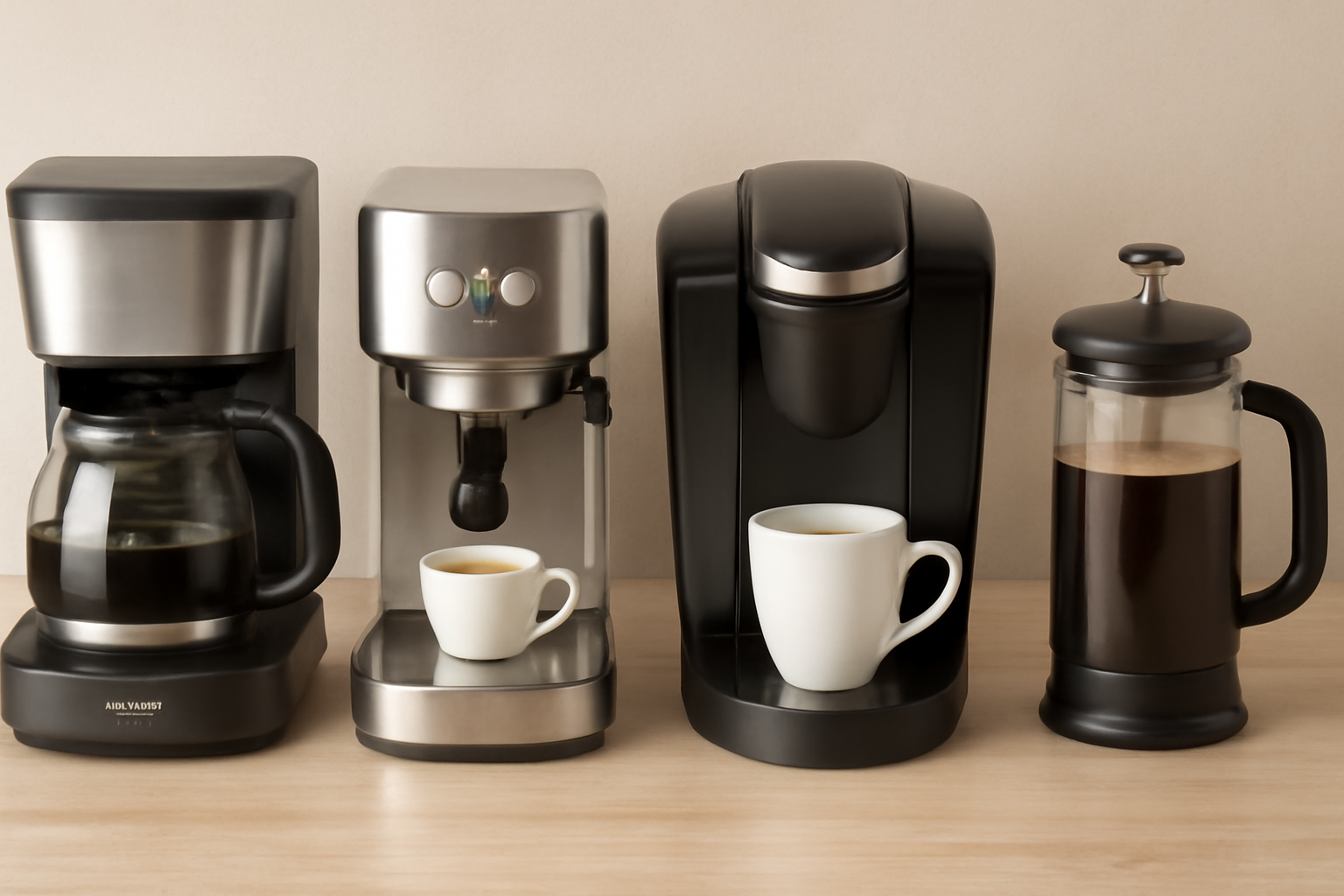For many, coffee is more than just a drink; it’s a ritual, a comfort, and the fuel that kickstarts the day. With so many coffee makers on the market, however, choosing the right one for your needs can feel overwhelming. From espresso machines to French presses and everything in between, each type of coffee maker serves a different purpose and offers a unique brewing experience.
In this comprehensive guide, we’ll walk you through the factors you should consider when selecting a coffee maker, highlight the different types available, and help you find the perfect one based on your preferences, lifestyle, and budget.
1. Factors to Consider Before Buying a Coffee Maker
Before diving into the various types of coffee makers, it’s important to take some time to evaluate your personal preferences and needs. Here are the main factors to consider when choosing the right coffee maker for you:
1.1. Brewing Method: What Type of Coffee Do You Enjoy?
The first step in choosing a coffee maker is determining what kind of coffee you enjoy most. Are you a fan of espresso, a strong and concentrated coffee shot, or do you prefer a milder drip coffee? Different coffee makers are designed for specific types of brewing, so knowing your preference will help narrow down your options.
- Espresso: If you love rich, bold coffee with a creamy crema, an espresso machine is your best choice. These machines brew coffee by forcing hot water through finely ground coffee under high pressure.
- Drip Coffee: If you prefer a classic cup of coffee with a more subtle flavor, a drip coffee maker might be the way to go. These machines are simple to use and brew coffee by allowing hot water to drip through a filter with ground coffee.
- Single-Serve (Pod): Single-serve coffee makers, like the Keurig or Nespresso machines, are great if you’re looking for convenience and speed. These machines use pre-packaged coffee pods or capsules and brew a single cup of coffee at a time.
- Manual Brew (French Press, Pour-Over): If you enjoy the hands-on experience of brewing your coffee and savor the process, manual brewing methods like French press or pour-over offer a more personalized approach. These methods require more attention to detail but provide greater control over the final flavor.
1.2. Capacity: How Much Coffee Do You Drink?
Another important factor is the capacity of the coffee maker. How much coffee do you drink on a daily basis? If you live alone and only need one cup in the morning, a single-serve machine might be perfect. However, if you entertain guests regularly or drink multiple cups a day, you may want a coffee maker with a larger capacity.
- Single-Serve Machines: These are ideal for individuals or smaller households. They typically brew one cup at a time, using either pods or ground coffee.
- Drip Coffee Makers: These machines often come with a carafe that holds between 4 to 12 cups, making them great for families or people who drink multiple cups throughout the day.
- Espresso Machines: Espresso machines can vary in size, with smaller models brewing one shot of espresso at a time, while larger models can handle multiple shots or cups.
1.3. Budget: How Much Are You Willing to Spend?
The price of coffee makers can range from affordable to high-end, depending on the features, materials, and brand. While it might be tempting to go for the most expensive option, it’s essential to consider your budget and choose a machine that suits both your needs and your financial situation.
- Budget Options: Basic drip coffee makers or single-serve machines can be found for under $50. These are great options if you’re just getting into coffee brewing and don’t need fancy features.
- Mid-Range Machines: For around $100-$200, you can get more advanced drip coffee makers, single-serve machines, or basic espresso machines. These will offer more consistent results and additional features like programmable settings or built-in grinders.
- High-End Machines: Premium espresso machines, high-end drip machines with advanced features (like grinders, temperature control, and automatic brewing), and high-quality manual brewing tools can cost anywhere from $200 to over $1000.
1.4. Ease of Use and Maintenance
Some coffee makers are incredibly simple and require minimal effort, while others offer a more complex experience. Think about how much time you’re willing to spend brewing coffee each day. Do you prefer the convenience of pressing a button and getting a cup, or are you more interested in the art of brewing and experimenting with different methods?
- Automatic Machines: If convenience is key, automatic machines like drip coffee makers and single-serve machines will brew your coffee with minimal effort. They’re perfect for busy mornings or for those who prefer simplicity.
- Manual Methods: French press, pour-over, and espresso machines require more hands-on involvement. If you enjoy the process and have the time to dedicate to perfecting your brew, these methods can be more rewarding.
Also, consider how easy the machine is to clean. Some machines, particularly espresso machines, require regular maintenance and descaling. Make sure you’re comfortable with the upkeep before purchasing a machine.
2. Types of Coffee Makers
Now that you know the factors to consider, let’s dive into the different types of coffee makers available on the market. We’ll break down the main types and their pros and cons.
2.1. Drip Coffee Makers
Drip coffee makers are the classic machines that most people are familiar with. These machines brew coffee by heating water and letting it drip through a filter with ground coffee. They are easy to use, affordable, and can make multiple cups of coffee at once.
Pros:
- Simple to use
- Brews multiple cups at once
- Affordable and easy to find
Cons:
- Limited control over the brewing process
- Coffee can be weaker than espresso or French press
2.2. Espresso Machines
Espresso machines are the gold standard for coffee lovers who enjoy rich, concentrated coffee. These machines brew coffee by forcing water through finely-ground coffee under high pressure. There are several types of espresso machines, including manual, semi-automatic, automatic, and super-automatic machines, each offering different levels of control and convenience.
Pros:
- Makes strong, rich coffee
- Great for espresso-based drinks like lattes and cappuccinos
- Variety of models for different needs
Cons:
- Can be expensive
- Requires regular cleaning and maintenance
2.3. Single-Serve (Pod) Coffee Makers
Single-serve coffee makers, like Keurig and Nespresso, use pre-packaged coffee pods or capsules to brew a single cup of coffee at a time. These machines are perfect for those who want a quick, convenient cup of coffee with minimal effort.
Pros:
- Quick and easy to use
- No need to measure coffee or clean filters
- Wide variety of flavors and pod options
Cons:
- Can be more expensive per cup compared to ground coffee
- Pods are not as eco-friendly as other methods
2.4. French Press
The French press (also known as a press pot or plunger pot) is a manual brewing method that immerses coffee grounds in hot water and then presses them through a filter. It allows for a rich, full-bodied cup of coffee and is perfect for those who enjoy a hands-on brewing experience.
Pros:
- Rich, full-bodied coffee
- Simple and affordable
- Allows for greater control over brewing time and coffee strength
Cons:
- Requires more time and attention than automatic machines
- Not ideal for making multiple cups at once
2.5. Pour-Over Coffee Makers
Pour-over coffee makers, like the Chemex or Hario V60, require you to pour hot water over ground coffee in a filter. This method allows you to control the flow rate and extraction time, resulting in a clean, flavorful cup of coffee.
Pros:
- High level of control over the brewing process
- Clean, nuanced flavor profile
- Affordable and easy to use
Cons:
- Time-consuming and requires attention
- Can be difficult to master for beginners
2.6. Cold Brew Coffee Makers
Cold brew coffee makers are designed to brew coffee using cold or room temperature water over a long period of time (usually 12 to 24 hours). This method results in a smooth, less acidic coffee that’s perfect for cold coffee drinks.
Pros:
- Smooth, mellow flavor with low acidity
- Can make large batches of cold brew
- Perfect for iced coffee lovers
Cons:
- Requires long steeping time
- Not ideal for those who prefer hot coffee
3. Conclusion: Which Coffee Maker is Right for You?
Choosing the right coffee maker depends on your personal preferences, brewing habits, and budget. Whether you’re looking for convenience, control over your brewing process, or a machine that can handle multiple cups at once, there’s a coffee maker out there to suit your needs.
- If you prefer a quick, easy cup, go for a single-serve coffee maker.
- If you love rich, concentrated coffee and want to experiment with different drinks, an espresso machine is ideal.
- For those who appreciate manual brewing and want more control over flavor, consider a French press or pour-over coffee maker.
- If you love smooth, low-acid coffee, a cold brew maker is a great choice.
Take your time, evaluate your needs, and choose the coffee maker that fits best with your lifestyle. Happy brewing!

I’m an economist with 15 years of experience in strategic planning and a lifelong passion for wellness and natural living. As a self-learner, I created Herbalife Balance to share insights on healthy eating, mindful habits, and an active lifestyle. Tennis enthusiast and nature lover, I believe in balance as a path to well-being. Through this blog, I help others live healthier, more conscious lives.

